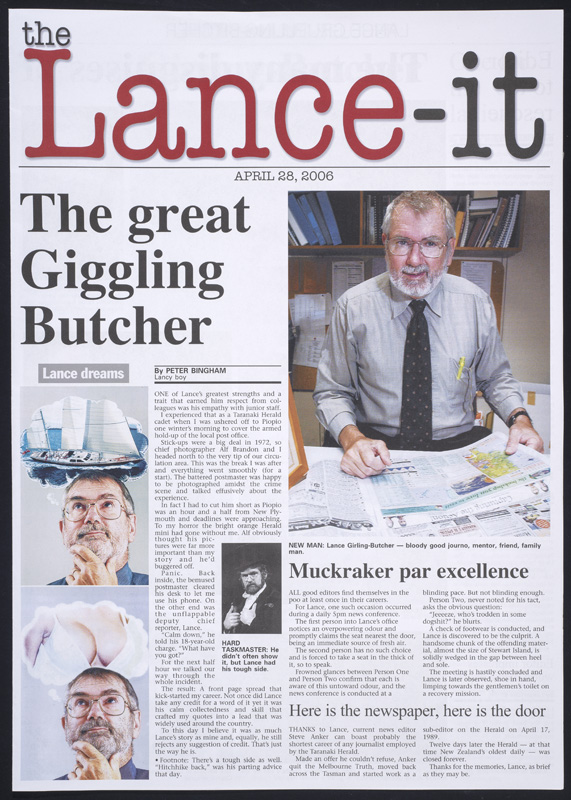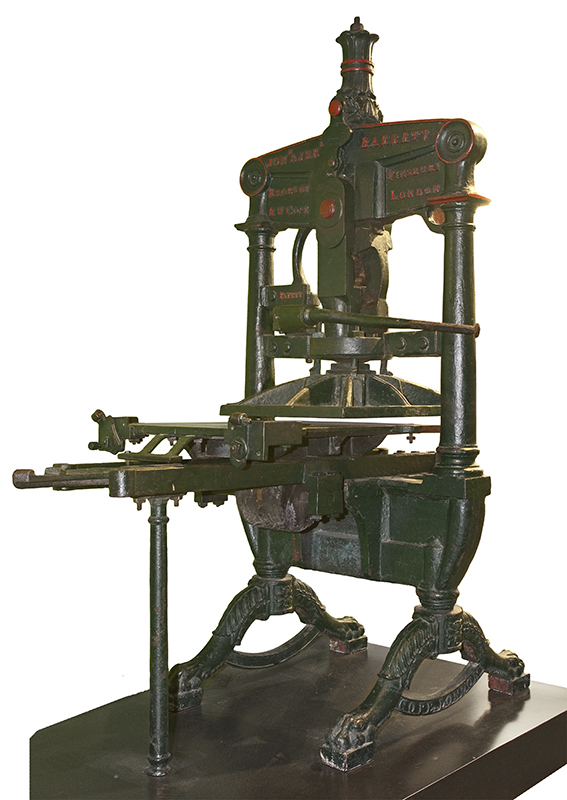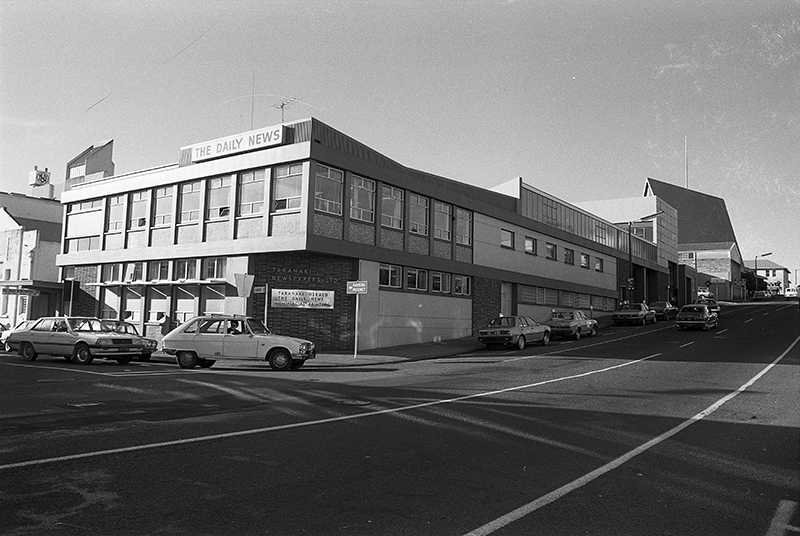




Read all about it! Death of the oldest newspaper in Taranaki!
Lance Girling-Butcher, long-time editor of Taranaki Daily News, remembers the demise of the Taranaki Herald as the most dramatic event in his newspaper career. “We had a bloody good wake” he says. “It went on all day and all night. It started here and wound up at my place.”
The year was 1989, and the wake marked the last gasps of a paper that first hit New Plymouth streets in 1852. The Taranaki Herald was the first paper ever printed in the province. Before the presses were silenced, it was the oldest surviving daily newspaper in the country.
In the 1950s, the Herald and the Daily News faced each other across Currie Street: a delivery boy could have thrown a paper from one building to the other.
In 1962 the papers merged on the present site to come under the umbrella of Taranaki News Ltd, a subsidiary of New Zealand News Ltd which published Auckland and Christchurch Stars. “The Daily News used to operate out of the building across the road in Roebuck House” says Girling-Butcher. “They had their own presses and both were wearing out. To achieve some kind of economy of scale they decided to merge the two companies into Taranaki Newspapers and buy one bigger, better, more modern press. This meant they had to construct this building, which was put beside the old Taranaki Herald building, with the press hall out the back.”
The old brick building that housed Taranaki Herald was demolished and rebuilt as part of the Daily News in a move that was probably not cost effective in light of the paper's demise. Girling Butcher, who joined Taranaki Herald just before the merge, says things might have been done differently had the powers that be known it was going to close. “One of the ironies was that when we decided to pull down the old Herald building and attach it to this one, the Daily News building, we had to move the reporting staff into Roebuck House and we ran copy across the road. We couldn't hear June screaming, that was great.”
The formidable June Litman, believed to be the country's first woman news editor on a daily newspaper was in charge of the Taranaki Herald at the time. Her drive for perfection and tyrannical rule of journalists was legendary.
When the building was finished, the troops moved back across the road where each paper had its own photographic and journalism department. Fierce competition made a wonderful training ground and everyone was a mate after work. “We used to have the old Imperial and the back bar saw quite a few journalists” says Girling-Butcher. “That's where everyone drank. They did a bit more drinking than they do now. They were rather more of the old mould - hard drinking, hardworking, hard smoking, the whole works.”
Many good men stalked the hallowed halls after taking the editorship helm - Rash Avery was one of the rare ones who was both editor and general manager. George Koea was deputy editor of the Daily News and later went across the road and ran the Taranaki Herald.
With the last provincial city in New Zealand about to lose its evening paper, the editor did all he could for the Herald staff. “My major preoccupation was to ensure the staff got a good deal over it and I still to this day believe they did. Most either moved to Daily News or went overseas and all seemed to do well.” Bought by Independent Newspapers Ltd (INL) in 1988, the Taranaki Herald lost its battle to retain circulation and advertising and went down the following year.
The Taranaki Daily News began on 14 May 1882 as The News. Initially published three times weekly, it was renamed in 1885 when daily publication began. The Taranaki was dropped from the masthead about 1962, at the time of the merger with Taranaki Herald.
The change recognised a growing circulation in the King Country, and to acknowledge that the newspaper went further than just Taranaki. In 2004, it was put back again, along with a colourful picture of the province's most well-known icon - the mountain, Taranaki. Both proved popular when tested against consumer groups. “People wanted it, my bosses wanted it because it made us conform with the rest of the group. Most of the regular papers have a geographic identifier in them” says Girling-Butcher.
Girling-Butcher believes the Daily News, like all good papers, still plays a very vital role in society today. “In the good old days, the information we conveyed was probably passed across back fences and through gossip. But we bring a certain authority to it because you can place a certain amount of trust in what we write, and the regulations and laws ensure we don't overstep the mark and defame people. I think we are there as a sort of public conscience and a public information source and I think we do a lot of good in a lot of areas.”
Specials have been issued since 1860s to mark major events such as political events during the Taranaki Wars, the surrender of Japan or a central city flood. The first ever afternoon edition, full of pictures, was delivered on 12 September 2001, a day after terrorists attacked the World Trade Centre in New York.
But for Girling-Butcher the most satisfying and significant story appeared after Cyclone Bola cut a swath through the region in October 1988. The storm began just as staff was coming to work. Two reporters, who happened to be down the beach end of Timaru Road, Ōākura, talking to a farmer, witnessed the roof of his house being blown off by the wind. Fortunately the storm abated, though the paper was late that day and didn't make the streets till 4pm. The circulation department rang every parent of every paper boy first, to check they were happy for their child to brave the weather. “It was just one of those unusual things” he says. “And it occurred to me that you can't ask children to go out into a storm adults were being warned about.”
The Wind Wand was a good example of a silly season story that grew into something that raised serious public debate. “It was one of those public controversies that catches peoples' imagination and we just saw wind wands popping up all over the place to ridicule the idea” Girling-Butcher says. “Look at it now, you hardly hear anyone say, 'Look at that thing.' Most people speak of it with pride.”
But it's a very old story that is the most fun to recount and it dates back to the days when he was a non-acting chief reporter. “I went to the council yards and I was chatting away to the guy there and he talked about the town clock.”
The town clock had moved its spindly arms from the steeple of the Post Office since 1907 until it was demolished in 1969 because of earthquake risk. “He said, 'You know we've got the workings here.”
After the story ran, someone wrote to the paper suggesting the clock be brought back on public display. Architect Terry Boon jumped on the bandwagon and offered to design something appropriate.
The Daily News ran a special publication that carried a dramatic image of the clock tower falling and joined Radio Taranaki to hold a Clockathon which raised $70,000 - a “whack of money” for the times. Eventually the New Plymouth District Council coughed up $250,000 to build a new clock tower where the old one used to stand, near the courthouse on Devon Street West.
“It's the sort of campaigning journalism that wins the affection of the readers and cements your place” Girling-Butcher says. “I think September 11 did it in a different way. It reminded people what a good paper they had, how flexible it was, that it was able to meet demands and bring them the news in a very dramatic way.”
Please do not reproduce these images without permission from Puke Ariki.
Contact us for more information or you can order images online here.